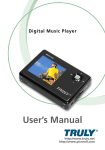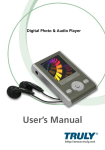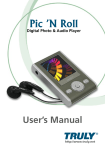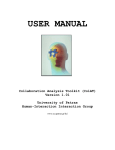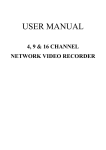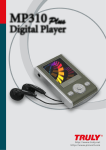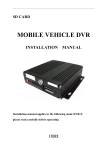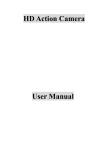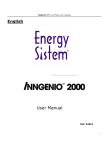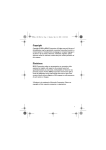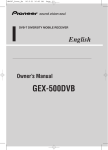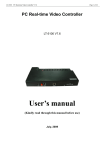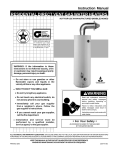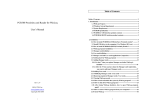Download 2 - Truly Electronics Manufacturing Ltd.
Transcript
Pic ’N Roll Digital Music Player MP313X User’s Manual http://www.truly.net http://www.picnroll.com Overview Welcome to the World of Pic ’N Roll! We are pleased that you have chosen the Pic ’N Roll MP313X Digital Photo & Audio Player. Please be sure to read this manual carefully before using this unit. Safety Instructions Please read this manual carefully before using this product for the first time. 1. This electronic unit is of high precision. Please do not try to disassemble this unit yourself. 2. Do not subject this unit to severe impact. 3. Do not expose to extreme temperatures, moistures, dusty area, magnetic field or direct sunlight. 4. Clean the unit with soft cloth. Avoid using any chemical solutions. 5. Do not subject to water. Avoid placing this unit near objects that contain liquor, such as glasses. 6. To avoid permanent hearing loss, please adjust the volume properly before use. 7. Do not try to modify any part of this unit. Only use the battery, charger and accessories that are recommended by the manufacturer. Otherwise, 8. it is dangerous and will violate the warranty terms. 2 9. Dispose of this unit and its accessories according to your local environmental regulations. 10. If you have any problems when using this unit, please contact your local dealer or our customer service center. Declarations 1. Truly Electronics Mfg. Ltd. assumes no responsibility for any damaged or loss data caused by accidental deletion of data as a result of malfunction, repairs or battery replacement. Making backups of important data on other media to protect against data loss is strongly recommended. 2. This manual is based on the first version of this unit. Should there be any changes, please see the revised manual in the supplied installation CD or the corresponding manual on our company’s website at www.truly.net. 3. Should there be any upgrade, please visit our website at http://www.truly.net to download the latest drivers. 4. The pictures shown in this manual may be different from the actual product screen. 5. Design of this unit is subject to change without notice. 3 FCC Notice: This device complies with Part 15 of the FCC Rules. Operation is subject to the following two conditions: (1) This device may not cause harmful interference. (2) This device must accept any interference received, including interference that may cause undesirable operation. 4 Contents 1. Introduction a) Product Features b) Package Contents c) System Requirements d) Connecting to your computer e) Specifications 8 8 10 10 11 12 2. Controls a) Controls/Jacks b) LCD Display c) Power 13 13 18 19 3. Operations a) Playing Music (1) How to set EQ modes, repeat modes and synchronized lyric display? (2) How to use loop repeating? b) Recording (1) Start Recording (2) Quick Recording (3) Source Selection (4) Settings (5) Direct Recording Setting 21 22 5 23 25 26 26 27 28 28 29 Contents c) FM Radio (1) Searching and storing a station (2) Search settings (3) FM recording (4) Delete a station d) Games (1) Slide pictures (2) Push box (3) Calculator (4) How to use options menu while you are playing a game? e) E-book (1) How to use bookmark list? (2) How to set auto flipping, auto flipping speed and locate page? (3) How to enjoy radio or music when you are reading an E-book? f) Browse pictures g) System Setup h) Memory management 30 31 32 33 34 35 36 37 37 37 39 40 41 42 43 45 44 4. Removable drive 51 5. Safely removing USB device 6 51 Contents 6. Installing, using and uninstalling TRULY MP313X softwares 52 7. Appendix Trouble shooting 58 58 7 1.Introduction a) Product Features 64,000 Color LCD • 1.8” Color Display with Photo Browser • Holds 2500+ JPEG images (Based on 500KB average file size) MP3, WMA, Secured WMA Playback • High quality digital audio playback. • Stores up to 250 songs (128KBps) Lyric Display • Edit and input lyric with the included software to display during song playback on your MP313X. FM Radio • 30 Preset Channels / Direct Recording of FM boardcasting SD Card Slot • Memory expandable to 2GB with a 1GB SD card. Direct MP3 Recording • Convert music from your favorite CDs, cassettes, and other sources into MP3 files via the supplied Line In cable without the use of a PC. 8 Voice Recorder • One-touch operation. Record lectures, seminars, and personal voice memos with the one-touch recording button. VAD option will activate/deactivate recording based on the player’s preset volume level. This option is best for recording long session with interval of silences. Text Viewer • Use this feature to view saved text files. Removable Drive • This unit can be used as a removable disk drive without the need to install a driver. (Windows 98 & Mac users will require to install the driver. Please refer to the supplied MP313X Installation CD for driver installation.) Rechargeable Battery • Built-in rechargeable lithium battery provides up to 9 hours of music playback per charge. Games • Built-in games that would give your mind a workout. Upgradable • This unit is firmware upgradable. Please visit our website at www.picnroll.com or www.truly.net for the latest upgrades. 9 b) Package Contents Please check the accessories in the package. Contact your local dealer for any missing accessories. ■ Earphone ■ Charger ■ USB Cable ■ Line In Cable ■ Holder ■ Armband ■ Installation CD ■ Quick Start Manual c) System Requirements ■ Microsoft Windows 98/2000/XP/ME ■ USB port ■ CPU Pentium 200MHz ■ CD-ROM ■ Up to 60MB of available hard-disk space ■ 32MB of RAM 10 d) Connecting to your Computer Connect the smaller connector of the supplied USB cable into the USB jack on the unit, and the large connector to a USB port on your computer. ATTENTION! WINDOWS 98 USERS: To avoid installation problem, complete installing the driver from the included CD-ROM before connecting the MP313X to the PC. 11 e) Specifications Model Storage media Interface Transmission speed Record format Bit rate WMA sampling frequency Recording length Display Battery : MP313X : 1GB Built-in Flash memory : USB2.0 Full Speed : > 600KBps : MP3 : MP3 (8Kbps~384Kbps) WMA (32Kbps~192Kbps) : support up to 44.1KHZ : approximately 18 hours (1GB, Medium Quality) : STN color LCD, 65536 colors, 160 x 128 pixels : High capacity Li-polymer battery : approximately 3 hours Battery recharge time Playing time : approximately 9 hours Maximum output : earphone 4.0mw x 2 FM frequency range : 87.500~108.000MHz (normal) 76.000~108.000MHz (broad band) Size : 75mm(length) x 52mm(width) x 15mm(height) 12 2. Locations of Controls a) Controls / jacks (1) (2) (3) (4) (5) (6) (12) (7) (9) (11) (8) (10) (17) (13) (14) (15) (16) 13 (1) Shoulder Strap Hoop Play and Pause track. (2) Microphone Built-in microphone for voice recording. (3) EQ Mode / Play Mode / Bookmarks When in play mode, press to change the EQ mode. When in E-book mode, press to place a bookmark. (4) REC (loop repeating) When in play mode, press to start loop repeating; When in FM mode, press to start FM recording. When in other modes except play and FM, press to start quick recording. (5) MENU / HOLD When in working modes, press to show the options menu. When in play mode, recording or listening to a radio program, press and hold to lock all buttons. When all buttons are locked, press and hold to unlock. When in file management mode, press to delete the selected file. 14 (6) Power ( ) / Escape (ESC) When the unit is off, press and hold to turn on this unit. When the unit is on, press and hold to turn off this unit. When in a submenu, press to go back to the higher-level menu. (7) Previous / Rewind ( ) Press to go to the previous track. When in play mode, press and hold to search within the current track. When setting the time, press to move the cursor. When setting EQ, press to change EQ mode. When manually searching a station, press to decrease the frequency. When in game mode, press to move left. (8) Next / Forward ( ) Press to go to the next track. When in play mode, press and hold to search forward within the current track. When setting the time, press to move the cursor. When setting EQ, press to change EQ mode. When manually searching a station, press to increase the frequency. When in game mode, press to move right. 15 (9) / (10) Volume Up ( + ) / Volume Down ( – ) When in play mode, press to adjust volume. When setting an EQ, press to adjust the value of a selected frequency. When in a menu, press to move the cursor. When in game mode, press to move up / down. (11) Play ( ) / Pause ( ) / Confirm When in standby mode, press to play. When in play or recording mode, press to pause. When in pause mode, press to resume. When in a menu, press to select and enter. (12) LCD Display Display the current status of MP313X, for example, the title and total time of the music being played. (Note: The text of a menu will scroll when the length of the text exceeds the width of the display). (13) Earphone jack Plug an earphone in this jack. (14) LINE IN jack Plug a LINE IN cable in this jack. 16 (15) USB jack / recharge jack When used as a USB jack, connect this unit to your computer using the supplied USB cable. When used as a recharge jack, connect this unit to a charger using the supplied USB cable. (16) RESET When the player is not functioning properly or down, press to restart the player. (17) SD card slot Insert an SD card in this slot. 17 b) LCD Display Playing Lock Music icon Volume Progress bar of playing EQ mode SD card Battery status No. of songs Elapse time Current folder Title Left/right stereo channel Paly mode or loop repeating Total No. of frequencies Current frequency no. Radio icon Frequency Progress bar of searching Radio status Frequency Setting FM level FM recording Current page number SD card Volume Page up/down Radio icon Content 18 c) Power There are two ways to recharge the battery: (a) connect this unit to the USB port of your computer using the supplied USB cable, press and hold REC button. (b) connect this unit to the charger using the supplied USB cable, as shown in the figure: MP3 Player Charger LED Indicator light USB Cable Note: 1. When the battery is being recharged, the battery icon in the display will flash. When the battery is fully recharged, the battery icon stops flashing and a full battery icon is displayed. 19 2. It takes approximately 3 hours to fully recharge a battery. To achieve better battery performance, we recommend charging the unit for an extra hour. If the battery is fully recharged avoid keeping this unit connected to the charger for a long tome. Recharge a battery for 5 hours after its first fully discharge. 20 3. Operations Turn ON: When the unit is off, press [ESC / on the unit. Turn ON: When the unit is on, long press [ESC / turn off the unit. * When ] to turn ] to Auto Sleep is enabled, if the unit is in standby and there is no operation after the set time, MP313X will automatically turn off to save battery. The Auto Sleep is disabled when the unit is in working modes (playing music or game, browsing photo or texts, receiving radio or recording) or is connected to your computer. If the Power Off Timer is enabled, the unit will automatically turn off at the time you set in any mode except when the unit is connected to your computer. 21 a) Playing Music In the main menu, as shown in figure 1, press [ ] or [+/–] to select “Play music” icon, press ] to select and enter the directory or music list, [ as shown in figure 2, press [+/–] to select a directory ] to play. When playing, the or a track and press [ lyric will be displayed when available, as shown in figure 3. When in play mode, “ ”as well as the volume levels of the left/right stereo channels are shown on the display, press [ ] to pause and the icon will change to “ ”. Press [ ] again to resume. Press [ESC / ] to stop playing and change to standby mode. Fig. 1 Fig. 2 Fig. 3 22 Fig. 4 Fig. 5 Fig. 6 Fig. 7 Fig. 8 (1) How to set EQ modes, repeat modes and synchronized lyric display? In play mode, press [MENU] to enter the music options menu. Press [+/–] to select EQ Adjust / Repeat Mode / EQ Mode (figure 4). 23 EQ adjust : Press [+/–] to select “EQ adjust”, press [ ] to enter the EQ adjust submenu (figure 5), press [ ] or [+/–] to set the value of each frequency. Repeat mode : Press [+/–] to select “repeat mode”, press [ ] to enter the Repeat mode submenu (figure 6), press [+/–] to select Repeat One/ Repeat All / Normal / Random. EQ mode : Press [+/–] to select “EQ mode”, press [ ] to enter the EQ mode submenu (figure 7 and 8), press [+/–] to select Normal / Rock / Bass / Classic / Pop / Live / Customize EQ. Shortcuts : In the play mode, press and hold [EQ] to change the repeat mode: Repeat one , Repeat all , Normal , Random . Press [EQ] to change the EQ mode: Normal , Rock , Bass , Classic , Pop , Live , Customized EQ . 24 Synchronized lyric display : when playing a song (MP3/WMA format), the LRC file, which has the same file name and in a same folder as the song being played, will be displayed. Up to 24 characters can be simultaneously displayed at a time (figure 3). (2) How to use loop repeating Segment [A-B] Repeat: when in playing mode, press [REC] to set the start point A, “ ” will be displayed. Press [REC] again to set the end point B, then “ ” is shown. Press [REC] again to cancel loop repeating. Fig. 9 Fig. 10 25 b) Recording This unit support FM recording, voice recording (built-in microphone), and direct recording (Line In). The recording time varies with the selected sound quality and the size of the available memory. ] or [+/–] to select In the main menu, press [ “Recording” (Figure 9). Press [ ] to select and enter recording submenu (figure 10). There are three options: Start recording, select source and set up. (1) Start recording Press [+/–] to select “start recording” and press [ ] to enter the recording submenu. When in recording mode, a working gear icon is displayed ] to pause recording and (figure 11). Press [ ] to resume the gear icon becomes idle. Press [ recording. Press [ESC / ] to stop recording and the system will automatically save the recorded file in the system directory. If the recording time is less than 2 seconds, press [ESC / ] , an error message is displayed (figure 12) and the recorded file is discarded. 26 Fig. 11 Fig. 12 Fig. 13 (2) Quick recording When not in play mode or recording mode, press and hold [REC] to enter the recording submenu. The operations are the same as those in “start recording”. Press [ESC / ] to stop recording and a confirmation dialogue is shown. The recorded file is automatically saved in the “Voice” system directory. 27 (3) Sources Selection MIC : built-in microphone. LINE IN : external audio signal input via LINE IN jack. Note : when “MIC” is selected as the recording source, a “Voice” directory will be automatically created. When “LINE IN” is selected as the recording source, an “Audio” directory will be automatically created. When performing an FM recording, a “Radio” directory will be automatically created. The recorded files will be saved to corresponding directories. (4) Setting Recording Setup includes: VAD setup and Quality (figure13). VAD setup (applies to MIC recording only): 1) Press [+/–] to select “VAD setup” and press [ ] to enter the submenu. Press [+/–] to select “VAD on” or “VAD off”. Press [ ] to return to the Recording setup submenu. When VAD is on, recording will not start until the volume level of the external signal exceeds a threshold set by the system. When VAD is off, the unit will start recording when “start recording” is pressed whenever there is any external source. 28 2) Press [+/–] to select “Quality” and press [ ] to enter the submenu. Press [+/–] to select the recording quality you want: low, normal and high. Press [ ] to finish setting and go back to the recording setup submenu. (5) Direct recording setting Connect one connector of the supplied LINE IN cable into the LINE IN jack on the unit, and the other connector to a LINE OUT jack of an audio equipment. This will ensure the recording will not be interfered by external noises. Press [+/–] to select “Recording” and press [ ] to enter the recording submenu. When finishing setting, press “Start ] to start recording. The Recording” and press [ recorded files will be automatically saved to the corresponding directory. Note: be sure to select “LINE IN” as the recording source. Fig. 14 Fig. 15 29 Fig. 16 c) FM Radio Note: When searching for a station, the earphone serves as an antenna. Therefore, please make sure that the earphone is connected to the unit. Otherwise, the unit will not be able to find any station. In the main menu, press [ ] or [+/–] to select “FM Radio” (figure 14). Press [ ] to enter the FM radio submenu (figure 15). Press [+/–] to select the ] to listen station you want to listen and press [ (figure16). When in FM radio mode, press [+/–] to ] to change adjust the volume and press [ station. Press [ESC / ] to exit and go back to the FM Radio submenu. If there’s no station stored in this unit, it will automatically enter the FM radio options menu (figure17). There are five options: Search for Channel, Frequency level, Step Setting, Band Setting, and Storage Mode. 30 (1) Searching and storing a station Press [+/–] to select “Search for Channel” and ] to enter “Search for Channel” press [ submenu (figure18). Press [ ] to manually search for a station. When a frequency is found, ] to store. Press and hold [ ] will press [ enter automatic search mode and press [ ] to save a station. TRULY MP313X can store up to 30 stations. If there are more than 30 stations, an error message will display (figure19). You will have to delete a station before you can save a new station in the system, or you can choose “overwrite Station”. Press [ESC / ] to cancel the current operation and go back to the channel search submenu. Note: Before channel searching, you can choose the “Storage Mode” (figure 20). There are two options: New Station and Overwrite Station. Fig. 17 Fig. 18 31 Fig. 19 Fig. 20 Fig. 21 (2) Search setting Frequency level: Press [+/–] to select “Frequency Level” and press [ ] to enter the “Frequency Level” submenu. Press [+/–] to select a frequency level (Low level, ] to Mid level or High level) and press [ confirm. This setting is trying to optimize the performance of the automatic search in different geographical locations. 32 Search step: Press [+/–] to select “Step Setting” and press [ ] to enter the “Step Setting” submenu. Press [+/–] to select search step (0.010MHz, 0.050MHz or 0.100MHz) and press [ ] to confirm. Band Setting: Press [+/–] to select “Band Setting” and press ] to enter the “Band Setting” submenu. Press [ [+/–] to select “US Band” or “Japan Band” and ] to confirm. press [ Note: the frequency range of the “US Band” is 87.5~108MHz. The frequency range of the “Japan Band” is 76.0~108MHz. (3) FM Recording When in FM radio mode, press [REC] to start FM recording. A rotating “ ” icon is displayed. ] to pause recording and the “ ” Press [ icon stops rotating. Press [ESC / ] to stop recording and exit and the system will automatically save the recorded file into the “Radio” system directory. 33 (4) Deleting a station In the station list, press [+/–] to select the station you want to delete, press [EQ] button and a “deleting a station” dialogue will pop up (figure21). Press [ ] to delete. If you want to cancel the operation, press [ESC / ]. Fig. 22 Fig. 23 Fig. 24 Fig. 25 34 d) Games In the main menu, press [ ] or [+/–] to select ] to enter the “Games” (figure 22). Press [ “Games” submenu (figure23). Press [+/–] to select [Slide Picture] / [Push Box] / [Calculator] and press [ ] to enter the selected game. Press [ESC / ] to quit. Press [MENU] to enter the game options menu (figure 24, 25). Fig. 26 Fig. 27 Fig. 28 35 (1) Slide Picture (figure 26) Operations: Press [ ] to start the game. You are allowed to move one step at a time. You can press [EQ] to browse the original picture. Press [ESC / ] to resume the game. Press [ ] or [+/–] to move up, down, left, and right to select the piece you want to move. The border of the selected piece will change to purple. Then, press [ ] or [+/–] to move the selected piece up, down, left, or right. Level: There are three levels: novice, normal, expert. There’s no time limit in the novice level and you are allowed to look at the original picture up to 3 times. There will be a limit on the total number of steps you can move in the normal level and you are allowed to look at the original picture up to 2 times. There will be limits on both the time and the total number of steps for the expert level and you are allowed to look at the original picture only once. Note: The selected piece can and only can be moved to an area where a palm icon is shown. 36 (2) Push Box (figure 27) Operations: Help the worker to push all boxes to the green dot areas. The worker is able to push one box at a time. The worker can enter the green dot areas when necessary. (3) Calculator (figure 28) Operations: Press [ ] to enter the calculator interface. Press ] or [+/–] to select 0-9, operators, decimal [ point and equal sign. When performing the following calculation “42+210=252”, “42” plus “212” equals to “252”. Select an operator to continue operations or press “C” to reset. (4) How to use options menu while you are playing a game (a) Select Picture: In the options menu, press [+/–] ] to to select “Select Picture” and press [ enter the submenu. Press [+/–] to select a ] to load the selected picture and press [ picture into the game interface. (Available in the “Slide Picture” options menu only) 37 (b) Level: In the options menu, press [+/–] to select ] to enter the “Level” and press [ submenu. Press [+/–] to select the level and press [ ] to confirm. (c) Reset: In the options menu, press [+/–] to select ] to confirm. “Reset” and press [ (d) Play Music: In the options menu, press [+/–] to select “Play Music” and press [ ] to enter the submenu. Press [+/–] to select the directory or track you ] to play and go back want to play. Press [ to the game options menu. Press [ESC / ] to resume the game. Now, you can enjoy the music when you are playing games. If you would like to adjust the volume or stop listening, press [MENU] to select “Volume Control” or “Exit Media” and press [ ] to enter the submenu. Note: In the options menu, press [+/–] to select “Enable/Disable FM Radio” (same operation as that of “Play Music”). 38 e) E-Books In the main menu, press [ ] or [+/–] to select ] to enter the “E-Book” (figure29). Press [ “E-Book” submenu (figure30) and press [ ] to enter the directory and file list (figure30). Press [+/–] to select the directory or file you want to read and press [ ] to start reading (figure31). Press ] to go to the previous or next page. Press [ [MENU] to enter the options menu. There are seven options: Bookmark List, Auto Page On/Off, Auto Flipping Speed, Locate Page, Play Music, Enable FM Radio, and Exit Media (figure 32, 33). Fig. 29 Fig. 30 Fig. 31 Fig. 32 39 Fig. 33 Fig. 34 Fig. 35 (1) How to use bookmark list In the E-book mode, press [EQ] to place a bookmark. A “ ” will be displayed (figure31). A file can have at most one bookmark and up to 4 bookmarks are allowed in the same directory. In the e-book options menu, press [+/–] to select “bookmark list” and press [ ] to enter the ] to jump to the submenu (figure34). Press [ page where the bookmark is placed. If you want to delete a bookmark, press [EQ] and a “remove bookmark” dialogue will pop up (figure35), press [ ] to delete. If you would like to cancel the operation, press [ESC / ]. 40 (2) How to set Auto Flipping, Auto Flipping Speed and Locate Page (a) In the e-book options menu (figure32), press ] [+/–] to select “Auto Page On” and press [ to enable or disable auto flipping. Fig. 36 Fig. 37 (b) In the e-book options menu (figure32), press [+/–] to select “Auto Flipping Speed” and press ] to enter (figure36). Press [+/–] to set the [ auto flipping speed and press [ ] to confirm. (c) In the e-book options menu (figure32), press ] to [+/–] to select “Locate Page” and press [ enter (figure37). Press [ ] to move the ] cursor. Press [+/–] to set the value. Press [ to confirm and the system will jump to the selected page. If the selected page does not exist, the system will jump to the last page of the file. 41 (3) How to enjoy radio or music when you are reading an E-book? (a) FM Radio: When in the E-book mode, press [MENU] to enter the options menu. Press [+/–] to select ] to enter “Enable FM radio” and press [ the station list. Press [+/–] to select the station ] to confirm and you want to listen. Press [ go back to the options menu. Press [ESC / ] to resume reading (figure31). Now, you can enjoy the radio when you are reading e-books. If you would like to adjust the volume or stop listening, press [MENU] to select “Volume Control” or “Exit Media” and press [ ] to enter the submenu. (b) Music: In the options menu, press [+/–] to select “Play Music” (same operations as those of “Enable FM Radio”). Note: this unit only supports text file in TXT format. 42 f) Browsing pictures In the main menu, press [ ] or [+/–] to select “Photo Browser” (figure38). Press [ ] to enter directory and photo list (figure39). Press [+/–] to select a directory or a file and press to confirm and enter the photo browser mode (figure40). Press [+/–] to change pictures. In the photo browser mode, press [MENU] to enter the options menu (figure41). There are two options: “Slideshow Speed” and “Enable Slideshow”. (1) Press [+/–] to select “Slideshow Speed” and press ] to confirm. Press [+/–] to change the [ slideshow speed. The value of the slideshow speed ranges from 4 to 99 seconds. Press [ ] to confirm. (2) Press [+/–] to select “Enable Slideshow” and press [ ] to enable or disable the slideshow function. When in the slideshow mode, press ] to pause slideshow and press [ ] again to [ resume slideshow. Note: this unit supports BMP, JPG, and Truly’s LOGO format. 43 Fig. 38 Fig. 39 Fig. 40 Fig. 41 Fig. 42 Fig. 43 Fig. 44 44 g) System Setup In the main menu, pres [ ] or [+/–] to select “System Setup” (figure 42). Press [ ] to enter the “System Setup” submenu (figure43, 44). There are seven options: Language, Backlight Timer, Adjust Contrast, System Reset, Power Off Time, Auto Sleep, and Version Info. (1) Language Press [+/–] to select “Language”, press [ ] to enter the submenu. This unit supports three languages: English, Simplified Chinese and Traditional Chinese. Press [+/–] to select the language you want. Press [ ] to confirm and the system will be updated based on your setting. (2) Backlight Timer Press [+/–] to select “Backlight Timer”, press [ ] ] to move to enter the submenu. Press [ the cursor and press [+/–] to set the values of the selected field and press [ ] to confirm. (3) Adjust Contrast Press [+/–] to select “Adjust Contrast”, press [ ] to enter the submenu. Press [+/–] to adjust the ] to confirm. contrast and press [ 45 (4) System Reset Press [+/–] to select “System Reset”, press [ ] to enter the submenu. A “system reset” confirmation dialogue will pop up and press [ ] to confirm. The unit will be reset. If you want to cancel the operation, press [ESC / ] . (5) System Reset The unit will automatically turn off at the time you set. Press [+/–] to select “Power Off Timer”, ] to enter the submenu. Press [ ] on press [ “Timer On” to enable or disable the automatically power off function. To set the time, select “Set Timer”, press [ ] to move the cursor between hour, minute and second, press [+/–] to adjust the values and press [ ] to confirm. Note that the unit will automatically turn off at the time you have set if the function is set to “Timer On”, no matter what operation is being performed. The default timer is set to one hour. 46 (6) Auto Sleep Press [+/–] to select “Auto Sleep” press [ ] to set the time. Press [ ] to move the cursor between hour, minute and second and press [+/–] ] to confirm. When to adjust the values. Press [ in standby mode, if there is no operation after the time period you set, the system will automatically turn off. The default auto sleep time is 3 minutes. (7) Version information Press [+/–] to select “Version Info.”, press [ ] and you will see the model name / version number / internal version number / date and other system information. h) Memory Managent In the main menu, press [ ] or [+/–] to select “Memory Mgmt.”. Press [ ] to enter the “Memory Mgmt.” submenu (figure 46). There are five options: Memory Info., File Info., Quick Format, Low Level Format, and Disk Select. 47 Fig. 45 Fig. 46 Fig. 47 (1) Memory management: Display the total size of the memory and the size of the available memory at the moment. (2) File information: Press [ ] to browse all directories and files in ] the root directory. Select a file and press [ to see the folder information. Press [MENU] to delete the selected file. Select a directory and press [ ] to enter the selected directory. (Note: can not delete a directory) 48 (3) Quick format: A “Quick Format” confirmation dialogue will pop up (figure47). Press [ ] to confirm. If you would like to cancel the operation, press [ESC / ]. (Note: ALL DATA WILL BE ERASED AFTER FORMATTING) (4) Low level format: (same operation as that of quick format) ❇ What is the difference between quick format and low level format? The main difference between the two types of format is that low level format will perform an error check, but quick format will not. If you just need to erase the data on the flash memory, a quick format is sufficient. However, if the unit went down from time to time, a low level format is required. 49 (5) Disk select: Press [+/–] to select “Disk Select” and press [ ] to enter the submenu. Press [+/–] to select the disks, which include local disk and SD card. Press [ ] to finish setting and go back to the System Setup submenu. When an SD card is inserted, you can choose either of the two disks as the active disk. When the SD card is selected as active disk, an SD card indicator will be displayed at the top-right corner of the user interface. When the SD card is locked, the system cannot delete or create files on the SD card. Note: Avoid removing the SD card while in use to prevent the player from malfunctioning. If this does occur, please press the “Reset” button once to restore the player. Always turn off the player before removing the SD card. 50 4. Removable Drive When Auto Sleep is enabled, if the unit is in standby and there is no operation after the set time, MP313X will automatically turn off to save battery. The Auto Sleep is disabled when the unit is in working modes (playing music or game, browsing photo or texts, receiving radio or recording) or is connected to your computer. If the Power Off Timer is enabled, the unit will automatically turn off at the time you set in any mode except when the unit is connected to your computer. g With the SD card slot, this unit can also work as SD card reader under Windows systems. 5. Safely remove the USB device To avoid data loss resulting from the sudden removal of the unit, please click the “ ” icon at the bottom right corner and follow the instructions. 51 6. Installing, using and uninstalling TRULY MP313X softwares Note: the following operations are performed in a Win2000 system. The screenshot may be different when these operations are performed in other operating system. a) Installation Insert the supplied installation CD in a CD-ROM in your computer. You will see the welcome screen shortly. (figure 48) Fig. 48 52 (1) You can find some useful information on how to use this unit by clicking “Read MP313X User Manual”. This manual is in PDF format. If you can not read PDF files, please click “Install Adobe Acrobat Reader” and follow the instructions. (2) You do not need to install any drives in Win2000/ME/XP. If you are using Win98, please click “install MP313X Win98 driver” and follow the instructions. After the installation, connect this unit to your computer using the supplied USB cable, you will see a “Removable Disk” in the “My Computer” directory. (3) Click “Install T-Music music manager” and follow the instructions. (including “LRC lyric editor”. “T-Music” and “U disk detector”) (4) Click “Image2Lgo” and follow the instructions. 53 b) Driver for MP313X Win98 Note: in Win98, this unit may not be recognized by the operating system. An “add new hardware” dialogue will pop up. Click “next” ➟ search for the latest version of driver for this hardware(recommended) ➟ Click “next” ➟ select the path: C: \Windows \Inf \other ➟ Click “next” ➟ Click “next” ➟ click “finish”. Connect this unit to your computer using the supplied USB cable. If the unit is successfully connected, “CONNECTED” will be displayed. At the same time, you will see two Removable Disks in the “My Computer” directory (say disk J and disk K). (1) Download (from computer to player) Copy the file you want to download and paste to disk J/K. (2) Upload (from player to computer) Copy the file on disk J/K and paste to the target directory. (3) Delete Select the file you want to delete, right click on this file and select delete. You can also press the “delete” key on the keyboard. 54 (4) Format Right click on disk J and select “format” (figure 49). Choose “FAT” (Do NOT select FAT32 or NTFS) in the “File System” drop down menu and click “Start” to start formatting. Fig. 49 c) Using T-Music Music Manager (1) LRC lyric editor Please see the help files for LRC lyric editor for details. (2) T-Music Please see the help files for T-Music for details. 55 (3) U disk detector If T-Music can not find the player, use U Disk Detector to help the system identifying the Removable Drive. (4) Using Image2Lgo This software will convert files in JPG, BMP, and GIF to Truly’s LGO format that can be best displayed by this player. Please see the help files for Image2Lgo for details. (5) Uninstalling T-Music1.00 Music Manager Double click “add/delete program” in the “Control Panel” (figure 50). Select “T-Music1.00” and click “change/delete” and follow the instructions. Or click “Start / Programs / T-Music / Uninstall T-Music”. (When uninstalling “Image2Lgo 1.0”, please follow the same steps) 56 Fig. 50 57 7. Appendix Trouble shooting Q: Why can some WMA format songs on the digital player not be played? A: There are many different music formats for songs on the Internet and many of them are in WMA format. Some of these WMA format songs are subject to DRM (license) copyright protection, which may cause unauthorized copies of some songs to become unplayable. This system protects the original owner of the songs. Some websites offer songs without license protection, and you may copy and play them as you wish - just like songs in mp3 format. However, some websites only offer songs in WMA format with license protection (for example: www.napster.com and www.musicmatch.com). To play these songs you can only use your PC with a Windows Media Player that has obtained the correct license protection. (Windows Media Player is a free Microsoft product that allows you to play WMA streaming media files. You can download it from many websites.) You cannot copy and play these songs on another PC without license protection. This prevents the spreading of unauthorized and illegal copies of songs and protects the song’s copyright owner. 58 If you have WMA format songs with the corresponding license protection, you still cannot just copy the songs from your PC to the digital player. You need to open Windows Media Player first. From its menu select “document”, “open” and open all the WMA songs you want to copy (if all of them can be played, you can transfer them to your player). Connect the digital player to your PC via a USB cable, and the screen of the player will display “Communicating”. Next a portable disk (e.g. F:\) will be displayed. Now click the “portable device” option on the left hand side of the Windows Media Player. A list of the music to copy will appear. Select all the songs you want to copy and then click the “copy music” button in the top left hand corner of the screen. The selected songs can now be transferred to your player with the required license protection authorization. Q: How many minutes of MP3/WMA songs can be stored on the player? A: This depends upon the player’s memory capacity, and how much is available for storage. One minute’s MP3/WMA music occupies approximately 1Mb of space, so if the capacity of the memory is 128Mb then it can store around 128 minutes of music. 59 Q: Having problems transferring files? A: (1) Please make sure that the USB cable is properly connected to the player and the PC. (2) Please check that there is enough memory available to accommodate the files that you wish to transfer. Q: Lost data? A: Some data loss can be caused by an unstable power supply during the transfer process. Our company does take responsibility for any files that are lost or damaged. We strongly recommend that our customers keep back-up copies of all important files. Q: Why do different songs play at different volumes? A: Depending on how a song is recorded, and how the volume levels were set at that time, songs can have different volumes levels and some can sound much louder than others. 60 Q: Why can some files, which are smaller in size than the available space on the player, still not be transferred? A: The CMOS chip inside the player allocates 16KB or 32KB to one memory track. A one Byte file will take one track. Therefore some files are smaller than the available memory but still cannot be transferred to the player. Q: Why my SD card in MP313X cannot be recognized as a Removable Drive under Windows 2000? A: Try downloading Service Pack 4 (SP4) for Windows 2000 and install it to solve this problem. You may find it via this link: h t t p : / / w w w . m i c r o s o f t . c o m /windows2000/downloads/servicepacks/sp4/ default.asp 61 Q: Why I can only download a limited quantity of files into my player while there is plenty of space on it? A: The number of files you can store in the ROOT directory of a local disk largely depends on the length of file names. The longer the file name is, the fewer files. A maximum number of 512 files are allowed to be stored in the ROOT directory. Note that this restriction only applies to the ROOT directory. Create as many folders as you need to store more files. Q: How do I create new folders in my MP3 player? A: Connect the MP3 player to your PC using the supplied USB cable. In the Removable Disk window, select File > New > Folder. Q: My player won’t start, what has happened? Could the following have occurred? : A: (1) During an upgrade of the player’s hardware, an accidental error might have occurred or the USB cable was unplugged. (2) The Flash disk has been physically damaged. (3) An unreliable power supply has resulted in an automatic power off after start up. 62 Technical Support Please visit our website at www.picnroll.com for the latest product information & downloads. If you are unable to find the solution in the FAQs, please contact us at [email protected], or call us at 1-866-pic-n-roll “Pic ’N Roll” is a registered trademark in the US Patent & Trademark Office. All other product or service names are the property of their respective owners. 2005 Truly (U.S.A.) Inc. All Rights Reserved. Specifications are subject to change without notice. 63































































